Expert Q&A: Frank K. Lake
By Amy Nelson
In the Fire and Fuels Program of the Forest Service’s Pacific Southwest Research Station, Frank Lake works on tribal and community forestry and related natural resource issues. His research focuses on restoration ecology and the incorporation of Indigenous knowledge into landscape restoration strategies, wildland fire and forest management, and climate change in the Pacific Northwest and northern California. He also has a research interest in wildland fire and management effects on cultural resources and tribal values. He is a Fireline Qualified Resource Advisor and has worked with tribes, agencies, organizations, and Incident Management Teams on wildland fire assignments. Frank serves as an advisor to The Nature Conservancy’s Indigenous Peoples Burning Network. Recently, more of his focus is working with tribes and for how Indigenous knowledge can be incorporated into scientific climate change research to support tribal vulnerability, adaptation and mitigation planning and related strategies. Frank has co-authored articles, book chapters, webinars and other technology transfer science products co-developed with a diverse range of collaborators. He has served as leadership of the TEK section of the Ecological Society of America since 2014. For the Pacific Southwest Research Station, Frank is the Tribal Liaison & Climate Change contact, and lead coordinating scientist for the Redwood Experimental Forest and Western Klamath Restoration Partnership landscape collaborative. Frank holds a B.S. in Integrated Ecology and Culture with a minor in Native American Studies from the University of California-Davis, and a Ph.D. in Environmental Sciences from Oregon State University.
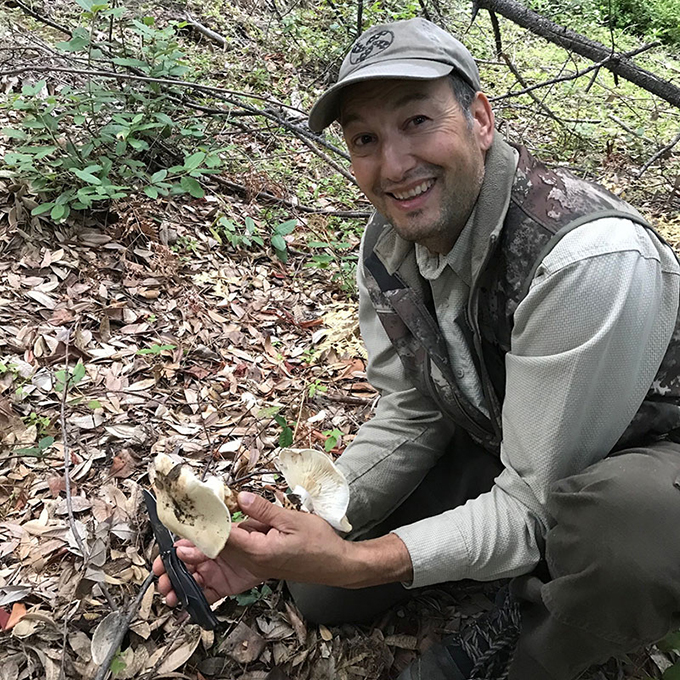
How do you define the term “cultural burn” or “cultural fire?”
Cultural fire is the use of fire for spiritual, subsistence, or other culturally specific purposes. On the spiritual side, it could be for making medicine, praying, or rituals. There are also utilitarian uses of fire, such as cooking salmon, deer meat, or elk on spits. Then there is the application of fire for the management of resources. Prior to governmental fire suppression, fire was used to clear out areas to have regrowth for things like basket materials, berries, and nut crops. Even though there was frequent lightning fire, and that was an important element understood culturally, a lot of meadows and forest openings were maintained through Indigenous peoples’ intentional and purposeful use of fire—in the right way, at the right time, and under the right conditions. In a cultural burn, fire was applied to gain beneficial outcomes that increased access to and the quantity, quality, and condition of the habitat or resources used for foods, medicines, and other materials.
Did you experience cultural burning for resource management in your childhood?
On the Yurok Reservation, I heard elders talk about burning, but it was prohibited and regulated by the government. I did maintain a relationship with fire as a high school student, though. My mom’s parents had property in West Point, which is in California’s Sierra Foothills, where there were black oaks, incense cedar…more of a mid-montane, Sierra forest type. I prescribed burned there with my grandfather. We burned to reduce fuels around the house but also to clear out areas. I was 14 or 15 years old, and I saw the benefit of those fires for acorn crops and deer hunting.
A little side story… It was one of those cool, windy nights on a full moon in March, probably during one of my spring breaks. I had little piles I was burning, but then the wind picked it up and boy, it swept. It went across the flat, down under the oaks, and through some of the cedars. It did not go up the trees, because we had kept the area pretty clear, but I remember running as fast as I could to try to get around it. Luckily it went out at the road and some trails we had in place. That taught me that you may think you have some control of fire, but there can always be unknown variables and things that happen unexpectedly. That put me in my place as a teenager. I thought, “I’m not going to burn unless my grandpa’s around!”
Indigenous peoples have used and continue to use fire for a multitude of reasons. That said, are there certain common threads when it comes to cultural fires on the landscape?
I’ve been to Australia to see how the Martu and others do cultural burning there, and I’ve been to some First Nations in British Columbia. I’m learning more—as a scholar and through my cultural networks—that there are some commonalities that really join Indigenous people and our relationships with fire.
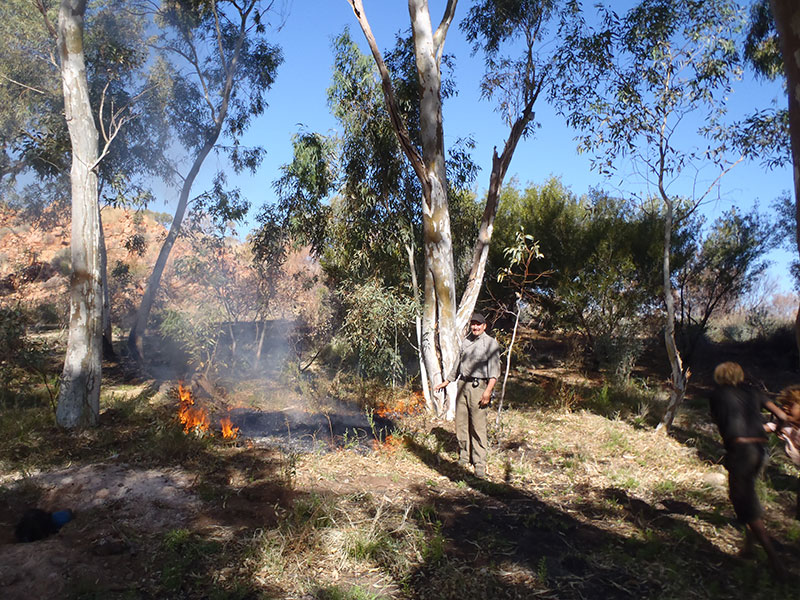
First and foremost, if you’re living in a fire-prone environment or ecosystem and you depend culturally upon fire-dependent species, through time and adaptation, and learning to live where you do through generations and across millennia, you become a fire-dependent culture. Through that, you have a high reliance upon and a highly significant cultural identity with fire. The same is true with water and other elements.
I have learned from elders, practitioners, and the fire-dependent cultures with which I have interacted that there is also a strong core of spiritual teaching and responsibility that comes from creation accounts in those landscapes. Fire is personified as an entity with agency, yet something you work with. With that core value, fire can then be used for food enhancement. It could be berries, but the berries will change with the environment, and the community, and the ecosystem. It could be for basket material. The plants will change, but there’s still a desired condition. If you burn in the right season, the right way, then you produce those resources that support the aspects of your culture. That’s one strong, unifying theme.
Of course, there is diversity across those different areas. There are wetlands, forests, prairies, semi-arid oak woodlands, shrublands, etc. Within those different ecosystems are a variety of different crops, medicines, basketry plants, and fiber plants, so the use of fire is prescribed by that condition and what is desired from those people who live there inter-generationally.
Are the actual methods of cultural burning as diverse and varied as the different cultures, landscapes, and ecosystems?
Very much so. In California, we have pitch sticks that you ignite and use like a pitch wand. Some people use other plants wrapped up, like a torch. There are all kinds of different local varieties of ignition to apply fire. What is more important is the complex understanding that if I burn at this time, in this way, the fire will produce the desired resource in the condition that I want. I think that is where the commonality lies: a strong sophistication on the gold standard, the best condition that can be achieved using fire in an appropriate way.
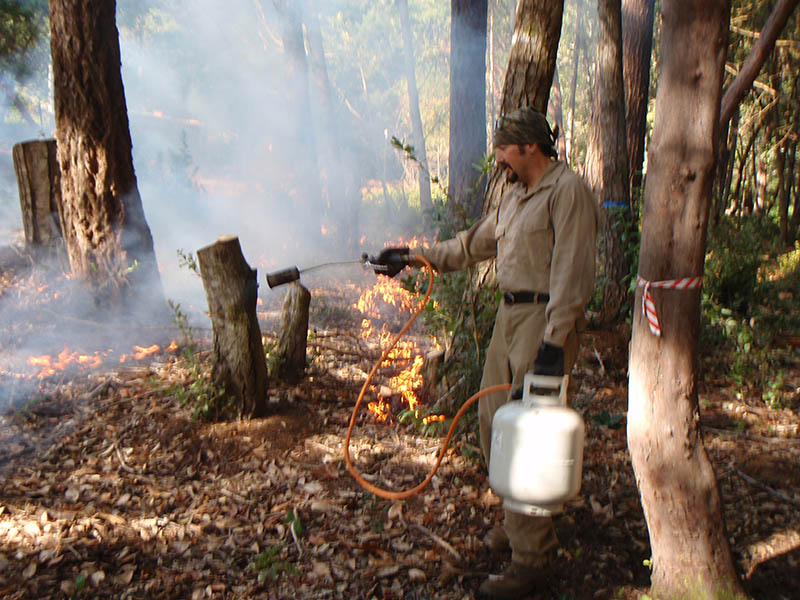
In the paper “Returning Fire to the Land: Celebrating Traditional Knowledge in Fire,” which was published in the Journal of Forestry in 2017, you and your co-authors presented a framework for improving fire management and research by applying both traditional knowledge and Western knowledge. What led to that work?
That work built upon the work of others. It came out of two workshops we had, one at the Salish-Kootenai-Flathead Reservation affiliated with the college there, and one at the 2014 Large Wildland Fires conference in Missoula, Montana. The workshops discussed challenges with using Traditional Knowledge in cross-jurisdictional management, fuels reduction strategies, wildfire management, and research.
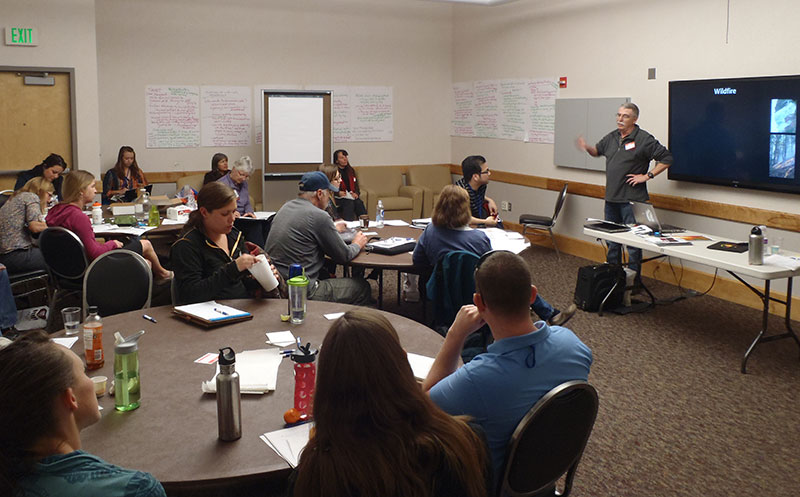
We welcomed to the table this Indigenous perspective on the importance of fire. We had fire practitioners, whether they were from tribal government, their own fire department, a natural resources or forestry department, or whether they were elders and practitioners, all talking about the cultural importance of fire. Then we had to be able to translate that through a Western science lens as well. In that regard, we looked at the framework of how these knowledge systems integrate, incorporate, and parallel each other. We looked at the ways in which they are similar and different, and how those similarities and differences bring us to a greater understanding of the relationship we can have as humans with fire.
One of the recommended actions in that framework is, “Contact tribes about planning and management strategies.” The paper also stresses the importance of partnerships. How would you describe an ideal partnership with an Indigenous community? What is important to keep in mind when attempting to establish trust and build that kind of relationship?
At the core of that question is trust. How do you build trust to even start a partnership? One thing that came out of the workshops was the importance of understanding the history and context of both the Indigenous people and fire, and then learning what you can about the importance of fire to their culture. What are also some of the challenges they’ve had, whether they were government-imposed or created by a colonial academic institution’s framing of fire as a natural ecological disturbance? Understand how those tones can be off-putting to your tribal partner. This requires “decolonizing” the Western academic or government understanding.
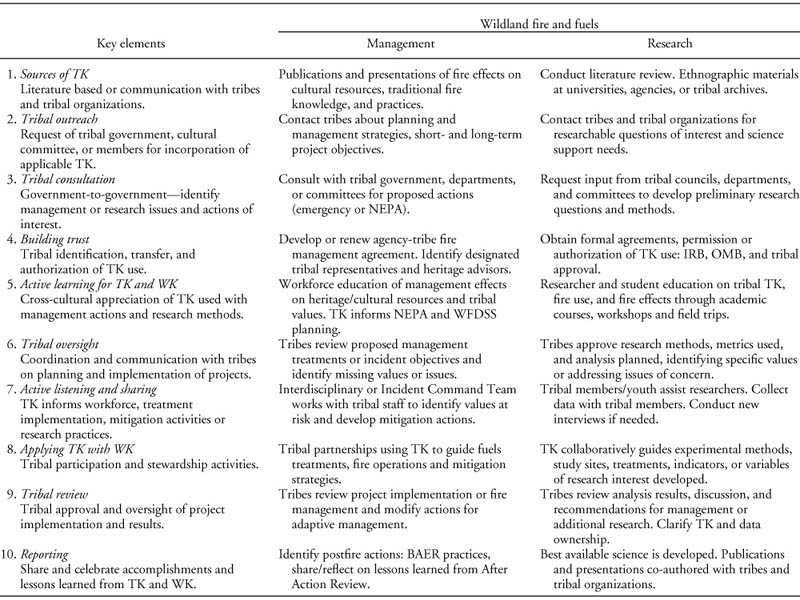
When you take the time to learn about and understand about a tribe, community, or environment– especially how fire is a part of that in various ways—you educate yourself. Then you have the ability to recognize some hard truths and go through the reconciliation process of thinking, “What has happened here? If a tribe wants to recover fire, what were the factors that contributed to the loss of their ability to use it?” So often, researchers or managers come in and say, “This is what we want,” rather than coming to the tribe and saying, “What is it that you want, and how can we be a partner to support you in that?”
As a researcher and manager, I can ask about their science support needs. What are their researchable questions? You also have to think about how and if you, under the principles of the United Nations Declaration on the Rights of Indigenous Peoples have free prior and informed consent for what you’re going to study. Do they want your help? Do they have a particular need that you have a certain capacity to help? Can you pool resources to help them address a management challenge or research need? That is at the core of it.
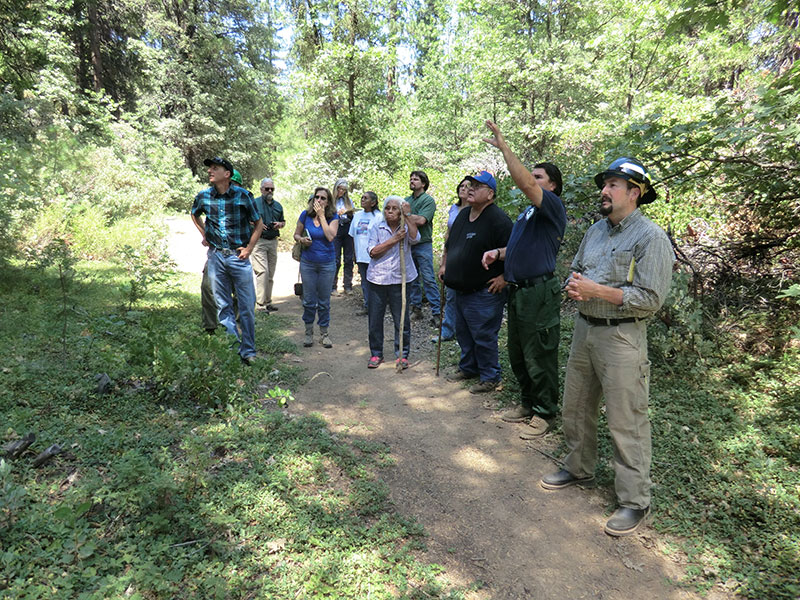
You also have to be willing to learn about that community and understand what you bring with your own history. The old adage is, “Hi. I’m with the Forest Service, and I’m here to help.” Yet that person, fresh out of school or having come from a non-governmental organization or academia, does not know the legacy and perhaps the trauma that they unknowingly represent. You have to be very open to some of those hard truths. It’s not that you did it, but you represent a certain institution that has a history that maybe wasn’t so kind, inviting, or inclusive of tribes. They may be a little wary of you.
There are also the extractive terms. I’ve heard people say, “We still need traditional ecological knowledge. It’s an untapped resource.” That is an extractive perspective because you want something from tribal people that will help you, rather than offering to help them.
How can restoration practitioners be sure they’re not merely extracting traditional knowledge, but allowing their work to be guided by an Indigenous worldview and principles of respect and reciprocity?
Realizing you may have conscious or unconscious bias is key. We talk about white fragility and colonial agency. It may not be you, but it may be part of the legacy you’ve inherited that you bring. You have to be willing to hear the hard truths of what has happened.
You should have been listening about a hundred years ago.
After a hundred plus years of genocide, forced removal, acculturation, boarding schools, laws prohibiting the use of cultural practices and religious freedom, and the Western colonial or land grant institution framing of places as “natural ecosystems” or areas that have not had Indigenous influence, to now come back and say, “We have this wildfire crisis. We have climate change. We see the destruction of the ecosystem services we depend upon. Now we’re willing to listen to you, Indigenous people.” You should have been listening about a hundred years ago.
Can you share any examples of collaborations or partnerships that have been Indigenous led, and resulted in not only ecological restoration goals, but also cultural goals of regenerating foodways, wellbeing, cultural practices, or even the restoration of the land itself to Indigenous communities?
One example is the Western Klamath Restoration Partnership (WKRP). I’ve been at the center of some of this work as an agency scientist and as a cultural practitioner here in Northern California. There has been tension, diverse perspectives, and differing values around how to do forest management and landscape restoration, and the best ways in which to manage fire or intentionally reapply fire. In order to help us overcome that, The Nature Conservancy came in and held a series of workshops through Open Standards for Conservation. We identified our values through public hearings, workshops, meetings, field trips, and get togethers. Then we had a results chain to see what our challenges were and where we had opportunities to accomplish shared values. From that effort, the Western Klamath Restoration Partnership was formed. The Forest Service is co-lead, along with the Karuk Tribe, the Salmon River Restoration Council, and the Mid Klamath Watershed Council.
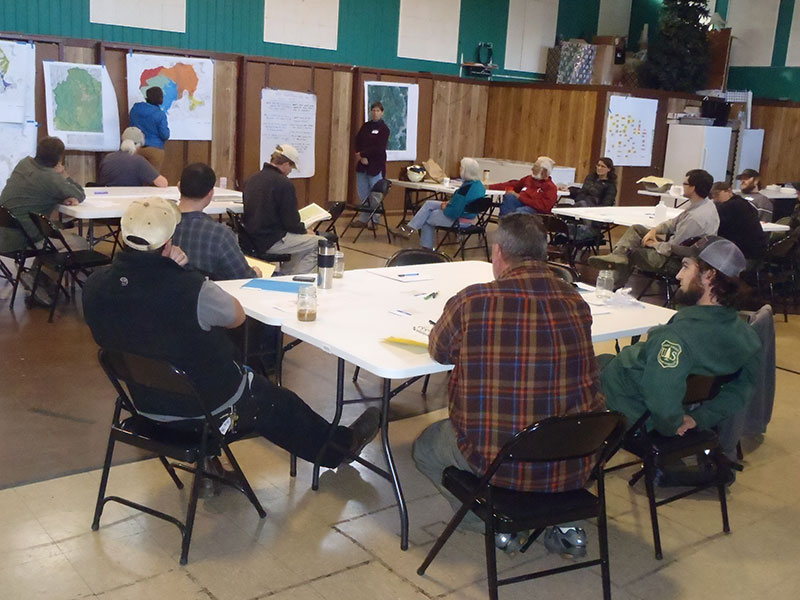
We took an “all lands, all hands” approach, across jurisdictions, for landscape-level strategy, because we need solutions commensurate with the size of the problem. Each entity had been siloed, managing private land, tribal land, and the Forest Service public land. But fire knows no boundaries, and it will move right across them. We saw an opportunity to come together to learn from and better understand each other. We did not always have to agree, but we had to respect our differences and formulate solutions for betterment of not only each individual entity, but all collectively.
As a WKRP core team member, initially I was a researcher leading the monitoring working group. I began to think, “What are the core science support and researchable questions this group has?” The Tribe wanted more research, and more research oversight and direction. They formed the University of California Berkeley and Karuk Collaborative. From there, I began to get involved with the academics, the Tribe, and community members to look at food security and food sovereignty.
If you live in a food desert, and the Tribe considers the suppressed, over-dense, fuel-rich forest as a genocide forest, it’s going to take proactive management from all kinds of partners to restore a healthier, functioning, resilient ecosystem, and forest types for productive and abundant basketry, food resources, and wildlife used for food and regalia. That has been our approach, and through that, we have also forged other partnerships with key people who, in many ways, are visionaries and hard workers. Partners learn how to best support each other and meet their own entity’s mission and needs while also being in service to the bigger whole.
Can you share a success/outcome of the WKRP that really illustrates what you just described?
The Karuk doesn’t have reservations, so the Tribe relies upon National Forest within its Aboriginal territory. The [Six Rivers] National Forest is basically land that was acquired from the Tribe through unratified treaties. Many of the areas that are private inholdings are former tribal camps or villages that became private property through settlement and colonization.
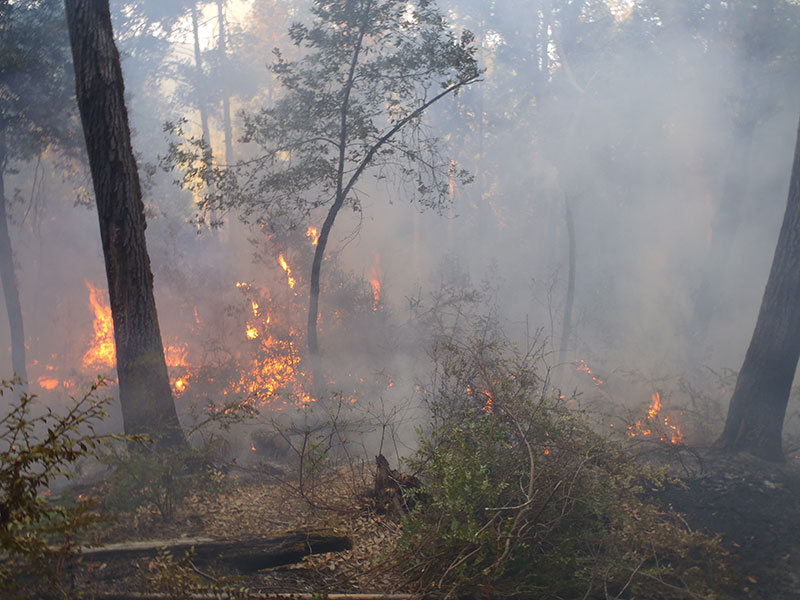
The WKRP’s Somes Bar Integrated Fire Management Project [which aims to integrate anthropogenic tribal fire use practices with emergent fire management analysis applications to foster greater collaboration among scientists, managers, and indigenous peoples to expand understanding of how human fire adaptive strategies affect fire-prone environments] looked at where there was the most alignment for investing capacity to protect and improve not only private land, but tribal land and the National Forest. One of the project’s four focal areas is Patterson, which is located between Somes Bar and Happy Camp, on the western front of the Marble Mountain Wilderness Area. Treatments in the Patterson area were selected based on shared values. We did a value overlay, and one place that came up was a site with large oaks that had historically been a gathering area. It was near private property within the National Forest, and there were key road features from which we can manage and access.
Indigenous knowledge helped formulate the prescription for the mechanical treatments – determining which trees to cut, which to retain, and how to promote wildlife habitat, food sovereignty, food security, and access to the big oaks and other hardwoods. Multi-entity crews then worked together on the unit layouts, data collection and then with administration of the mechanical logging treatments. Then, they came together last year to do a cooperative burn under the Nature Conservancy’s Prescribed Fire Training Exchange (TREX) burns. I brought my kids on that burn, and I did so because we are people of fire. If we don’t get out there and see fire, how are we going to be knowledgeable and active community members in the future? It starts with educating your youth. That was another shared value: intergenerational learning.
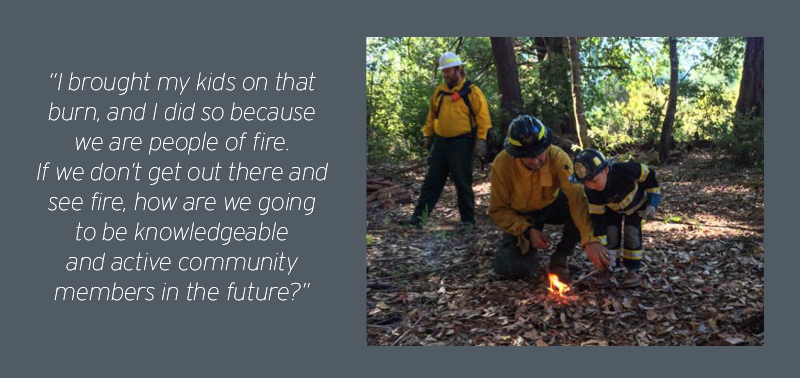
We recently took a field trip to [that site in Patterson] with Cal Fire representatives to demonstrate prescribed burning with cultural objectives done in partnership. It was so open and clean. It had very little wildfire risk and you could see the plants rebounding. Some of the areas had plots, so as a scientist, I can do pre- and post-fire measurements and evaluate the burn quantitatively. As a cultural practitioner, I can see good acorns and healthy, old legacy trees. Nature is teacher. If those big old legacy hardwoods that formed over hundreds of years under prior Indigenous management had burned up in a wildfire or had been cut down and replaced with conifers that were valued for timber, we would have missed the opportunity to learn from nature about how we live with fire.
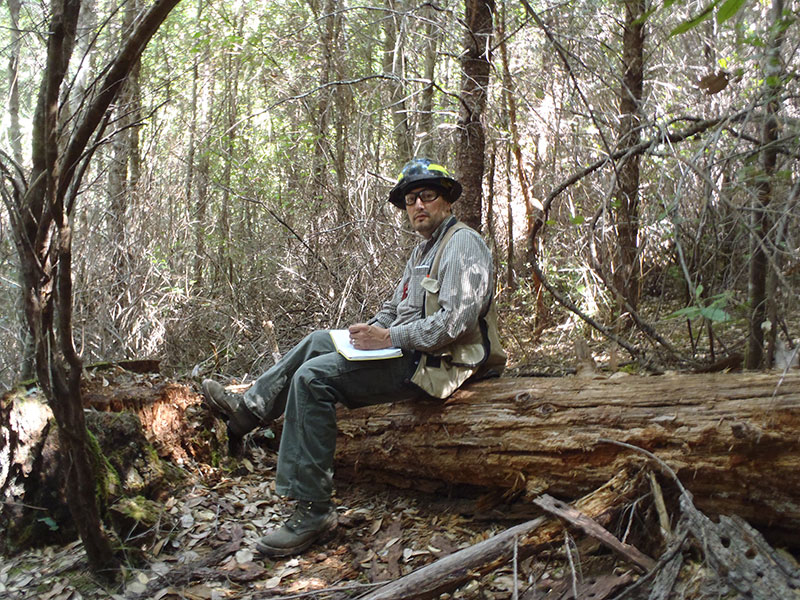
That burn was one small but very important step towards success. The private land is protected from wildfires and there is now tribal access to the acorns, and to hunting and gathering opportunities.
What can Western practitioners learn from the participatory nature of cultural fire?
One, be humble and recognize that you don’t necessarily have all the answers. Two, listen and be open to learning diverse perspectives. You don’t have to agree, but you do need to acknowledge and consider. In the case of [the Somes Bar Integrated Fire Management] project, it was about promoting the hardwoods and legacy trees, and not about meeting a timber target. It was about seeing that we could achieve both entities’ objectives. They were related, but different.
I remember once meeting with a tribal forester in Oregon who kept saying, “Working for the Tribe, it’s important to restore ecological disturbance regimes.” I said, “No. You’re working for the Tribe, and this is an Aboriginal territory. It’s about reinstating Indigenous stewardship regimes. It took generations over millennia to put this in place, and it took colonization, resource extraction, and industrial logging to degrade it and make it less functional.” Part of the process is cultural revitalization.
It seems like there is a lot of Indigenous wisdom about a site’s fire history from that can’t be learned otherwise. Do you see that happening in partnerships like the WKRP?
Very much so. That was the case in an academic partnership for an interdisciplinary, multiple-methods study involving paleo climate, which was published in the proceedings of the National Academy of Science by Clarke Knight. We had the lake core with charcoal and pollen; the fire history, which involved looking at fire scars on log cuttings; and ethnographic information from maps and historical accounts of why and how tribes used resources and managed fire there. We were able to demonstrate, through those diverse interdisciplinary approaches, that just one on its own wouldn’t necessarily give you the fullest picture. [See this video of Dr. Clarke Knight, US Geological Survey presenting this study]
We talked about holistic resource management and stewardship, but you also need to be holistic in your research to create that best available science together. For an Indigenous person who lives in a storied landscape, who has a creation account from that place, and who sets down what we call the natural or Creator’s laws about spiritual responsibility and how you govern and conduct yourself, details that may never have been recorded can be the tenets of stewardship, and progress is measured using indicators. If we, as ecologists, are not willing to talk to our Indigenous colleagues, we might not be measuring the right thing to account our success.
For part of the interdisciplinary paleo climate study, we worked with basketweavers to do some initial cultural or prescribed burns. Yes, we were doing hazardous fuels reduction, but we were also clearing around oaks for acorns, wildlife habitat, and hazel shoots for basket making. Hazel bushes that were overgrown, shaded, and had kinky stems, could be coppiced or burned to generate nice, long shoots that are ideal for baskets. The metric here isn’t “percent cover” or “density;” it’s the number of usable, straight stems with which you can make a basket to carry grandkids, use in a ceremony, or gather berries, roots, acorns, or hazelnuts. It’s all so interrelated. We ecologists and Western-trained scientists must be open to learning about relationships we haven’t conceived of or been taught (see Marks-Block et al. 2019).
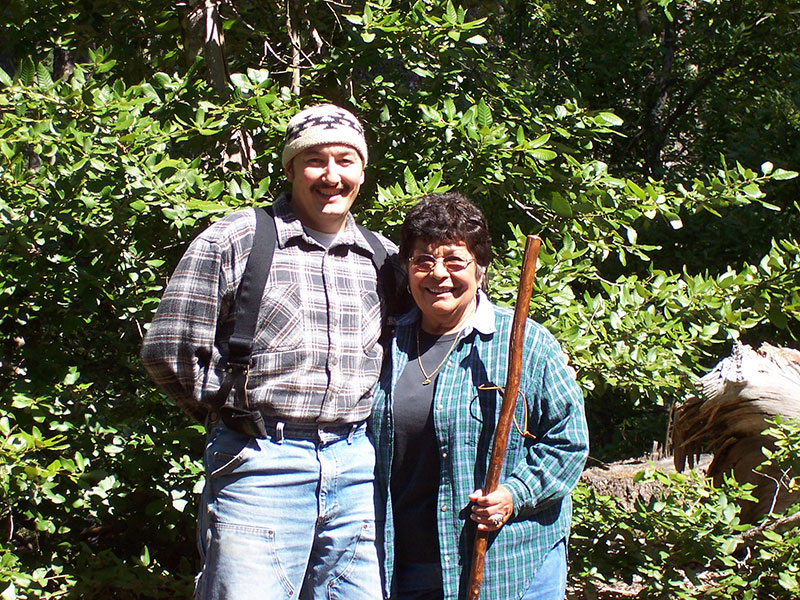
Many of our readers may want to support Indigenous efforts to return burning to their land, or to collaborate with Indigenous communities in doing burns, but they may not know where to begin. Are there entities or organizations that could be helpful?
I serve as an advisor to the Indigenous Peoples Burning Network at The Nature Conservancy, which grew out of our work with the Western Klamath Restoration Partnership. The Indigenous Peoples Burning Network started with the Hupa, Yurok, and Karuk and our Healthy Country Plan. It is now directed by Dr. Mary Huffman, who was one of the facilitators of workshops I mentioned earlier, and it is a good resource. There was recently a great article about a partnership of the Indigenous Peoples Burning Network, the Forest Service, and the Leech Lake Band that is burning for pines and for blueberries in the Chippewa National Forest.
I have found basketweaver associations to be very helpful. The California Indian Basketweavers’ Association holds annual meetings, and they have open-to-the-public days. You can go see weavers and say, “I have learned a little about how fire is important for basket weaving. Could you please tell me more?”
A lot of tribes also have tribal reunions and other festivals. There are booths, vendors, events, and demonstrations, and it is a great way to interact with tribal communities. Some state parks and other entities co-host tribal events and demonstrations that are open to the public, and that is a good way to get in. Tribal museums or cultural centers can also be great opportunities. Seeing the displays and talking to the curator, who is a local tribal person, is a great way to learn. Hopefully you meet someone who’s open to what you want to bring to them, and you can begin forging a partnership. Tribes may be busy and have varying capacity to respond, but you can also reach out to them.
We’ve talked about the historic atrocities of genocide and the criminalization of Indigenous practices. Are today’s megafires, which are partially the result of those past actions, bringing yet another form of environmental injustice to Indigenous communities?
That is deeper to unpack. The severity and magnitude of today’s wildfires are exhibiting uncharacteristic behavior not only in the memory of tribes, but also in the body of our science.
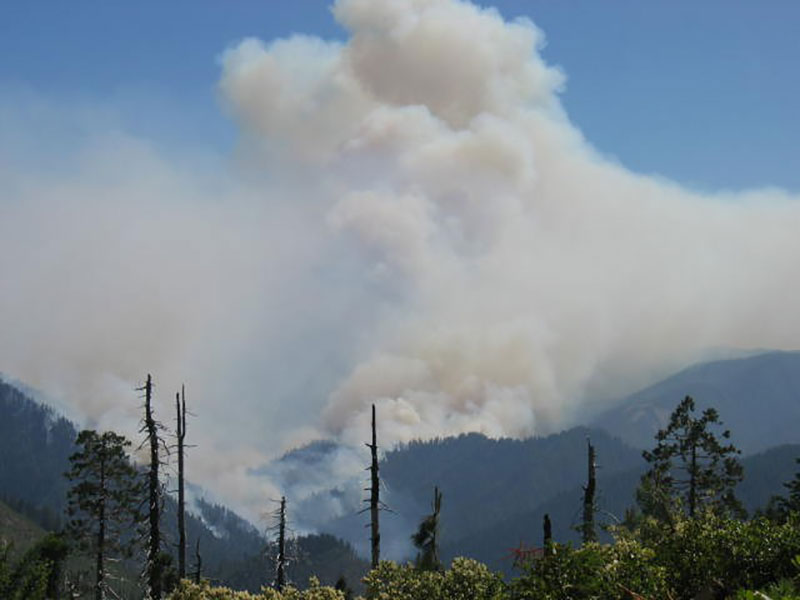
With two-eyed seeing, I had the Western academic perspective that lightning created natural fire regimes (which I had to debunk and decolonize). Then I had the cultural teaching about the importance of burning—for food, material, wildlife habitat, trails around sacred sites, and more. It reduced fuel loading and added a very fine mosaic of heterogeneity. It promoted drought-tolerant tree species and rich ecotones between former recent burns. It promoted springs and perennial water.
As a scientist, you might have been led to think that nature did those services through lightning, that fire suppression alone caused the buildup of fuels, and that now climate change is exacerbating everything. But that is a bit of a scapegoat. In many places across North America, the most fire-prone environments were those most frequently managed by Native people. Those areas were the most changed because Native people were removed, and burning was outlawed. There were also the factors of industrial forestry and fire suppression, but there’s more behind today’s megafires than just climate change. A legacy of colonial forestry and fire management has contributed to this.
Are Indigenous communities disproportionately impacted by these fires because of where they are located?
Yes, very much so. Many rural tribal communities are in mountainous, fire-prone areas. It is ironic that, early on, the first fire suppression workforces were Indian crews that were “voluntold” to go suppress fires. During the creation of the hotshots and the more elite firefighters, a lot of them were Indian crews because they had the knowledge of the mountains and their resources, and how to use fire. But that, to me, was colonially mandated fire suppression. A lot of the elders I have interviewed talked about how they had to have jobs in forestry or fire. They realized the damage it was doing, but that was the only income they had.
Are cultural burning practices now being taught in tribal and/or non-tribal universities? Are we starting to see recognition of this approach in academia?
It’s slow. But I can tell you, I bring my children out on safe burns and my own five-year-old has been out on a cultural burn on our property, and people are often taken back. They’re like, “How can you endanger your child?” Those are the same kind of colonial settler perspectives that justified taking Native children away and sending them to boarding schools. It is a cultural imposition, judging whether or not tribal people have the competency and experience to utilize fire, and it is still very much an undertone of Western academically trained people.
I have a tribal colleague who related to me they included a photo of children in a burn area in a federal BIA grant attainment report, according to them-the BIA person said, “You should not have had children out there. That was an endangerment.” But that’s not the Indigenous model. When I was in Australia, I saw eight to ten-year-olds burning small patches, teenagers burning slightly larger patches, and adults burning big swathes. Knowledge and the use of fire is a responsibility. Like anything, you’re trained from a young age to gain capacity, to build up your repertoire of knowledge and practice so that one day you can conduct a cultural burn. But if you’re not there on the side of your grandfather, grandmother, aunt, or uncle when you’re doing that, you’re not going to get that direct experience. You’re not going to be the person who lit the fire under mentorship and supervision and then gets to come back to gather basket materials or berries. You will not be the young man who gets to go into that burnt area to hunt that first year elk and share that food with the community, make a drum or dress out of the hide, or use antlers for regalia. It’s not just the burning; it’s the whole cultural process that goes along with respecting and honoring what you do when you use fire. That, for me, is Indigenous fire stewardship, and cultural burning is a component of that.
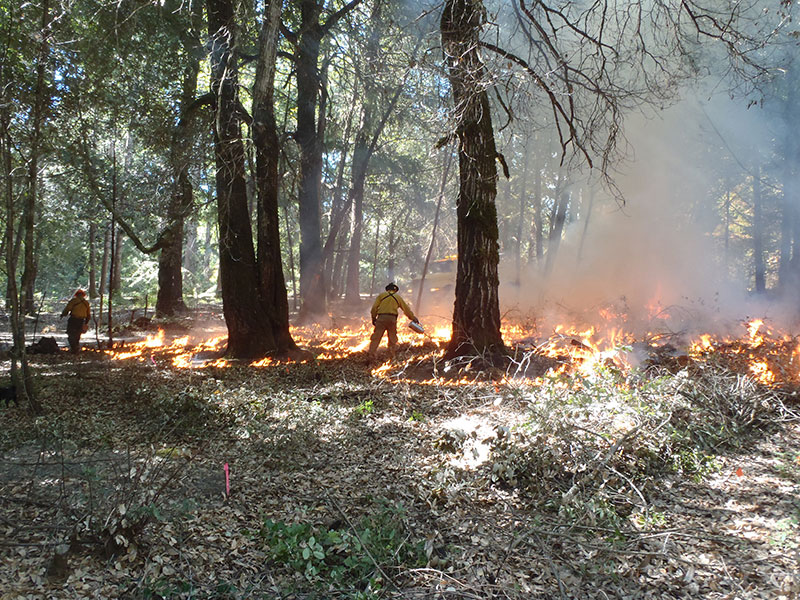
Can you tell me about your work in Indigenous agroforestry, and the role that fire plays or could play?
I am currently helping to write a chapter for the silvics book and addressing tribal agroforestry, or re-recognizing that. We have these conventional tribal agroforestry practices, whether they’re forest gardens, windbreaks, riparian alley cropping, or silvopasture. There are Indigenous models all across North America. Many prior Indigenous agroforestry relationships were with those hardwood forests—the pecans, oaks, and fruit orchards—but they weren’t recognized as such.
When you look at the west of North America or the Mound Builders in the Mississippi valley, you can see agriculture: the corns, beans, and squash. But what about all the rich, fertile lands from that outer riparian floodplain into the mountains, foothills, and ridges that now, because of fire exclusion, colonization, or logging, have completely changed? In addition to acknowledging the natural, environmental, biophysical component of [fire and fire suppression] on soils, climate, and vegetation, we need to think about how tribal agroforestry, through generations, really fostered much of the diversity.
There are some great examples for forest gardens here on the West Coast. There is a rich diversity of plants, overstory, and understory around villages. For us to be taught, in our botany, forestry, or environmental science class that those were natural areas of biodiversity, is erasure of Indigenous people. But using cultural anthropology, ethnographic information, listening, and actually considering what living Indigenous people say about their villages and lifeways and how they want to restore them, puts us at the forefront of agroforestry. It wasn’t just a rich, biodiverse area; it was a forest garden that kind of went feral, but now has a potential to be revived. When you begin to look at which plants were unknowingly assumed to be natural which were major food, basket material, and medicinal plant understories that hosted habitat for pollinators and other wildlife, and which areas were more buffered from ecological disturbances, that’s part of agroforestry for me now. How do we acknowledge the legacy of Indigenous stewardship that is on the landscape?
It might even be down to things where we’re like, “There’s this really unique subpopulation.” No, it’s probably a cultivar of those berries, or that fruit crop, or that medicinal plant patch that, for many ways, was never given the consideration. I am interested in decolonizing the way that we look at North American ecosystems, habitats, resources, and think, first and foremost, “Was that cultivated by Indigenous people?”
If we want to restore that, and if we really consider that as part of our baseline, and not the shifted baseline we started measuring in 1940 with our first plots or aerial photographs, Indigenous knowledge can help us understand the true integrity of that system: what it has changed from and what the potential it may hold for recovery. Then we can begin to honor not only Indigenous knowledge, but a place where human agency has adaptive capacity in the face of climate change.
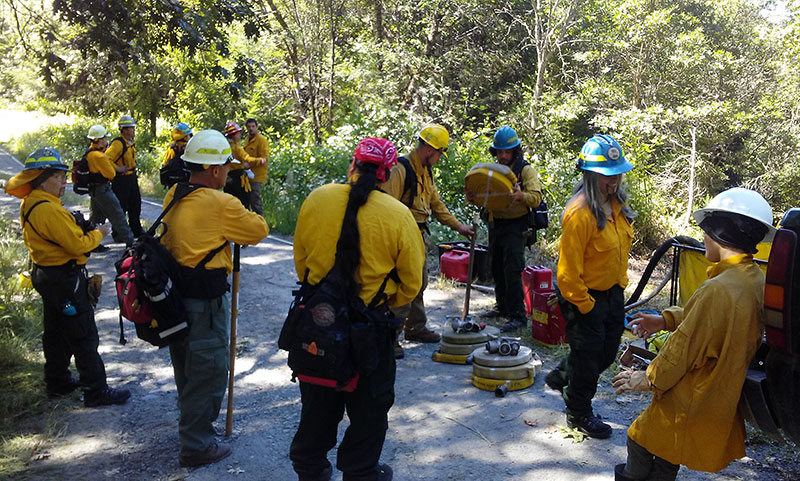
Through time, Indigenous peoples learned that fire is an extremely efficient, energetic tool when applied at the right time, in the right way, and at the right dosage. Again, fire is medicine. When you have the indicators of an overgrown area— you’ve lost the light, you’re losing your flowering, you don’t have the pollinators, you don’t have the fruits, berries, or nuts—and then you burn it and it recovers, then that’s the right dose. If you are looking at using mushrooms as indicators, and you can still burn an area, but you have enough duff or that rich organic layer to have a rich, integrated mycelium and ectomycorrhizal relationship between the tree, the shrub, the mushroom, and everything else in the soil, then you’re looking at a way of integrity. For that holistic perspective, when it comes down to fire, each tribal community within each place will have a variety of indicators about how fire promoted, or decreased, or changed those conditions.
How can people learn more about Indigenous agroforestry, including the role of fire? Have you published on this topic?
I’ve just come out with a Pacific Northwest Tribal Agroforestry storymap with Ecotrust. I presented a tribal agroforestry webinar last May at the 13th Annual Agroforestry Symposium. Colleen Rossier (a former grad student from the University of California Davis, currently with Karuk Tribe Department of Natural Resources) and I have a publication on traditional knowledge in agroforestry.
I am also managing my property this way. I thin out stuff, burn, replant, and then go back in and try to use fire to keep clearing out places. It began as a cooperative burn, the Klamath River TREX in October 2015 because I was reintroducing fire to a place, and I had to have extra backup and resources to make sure it was safe. After we got a few fires in there and areas cleaned out, I continued with my family. I use things like the Natural Resource Conservation Service’s Environmental Quality Incentive Program (EQUIP). After developing a conservation plan, through my conservation practices like forest stand improvement and woody debris disposal, I can reduce hazardous fuels, protect my home from the adverse effects of wildfire if it were to occur, promote more drought-tolerant, fire-adapted tree species, and open up the understory to provide a whole range of other services. In addition to a big garden, I now have a little orchard with acorns and hazelnuts.
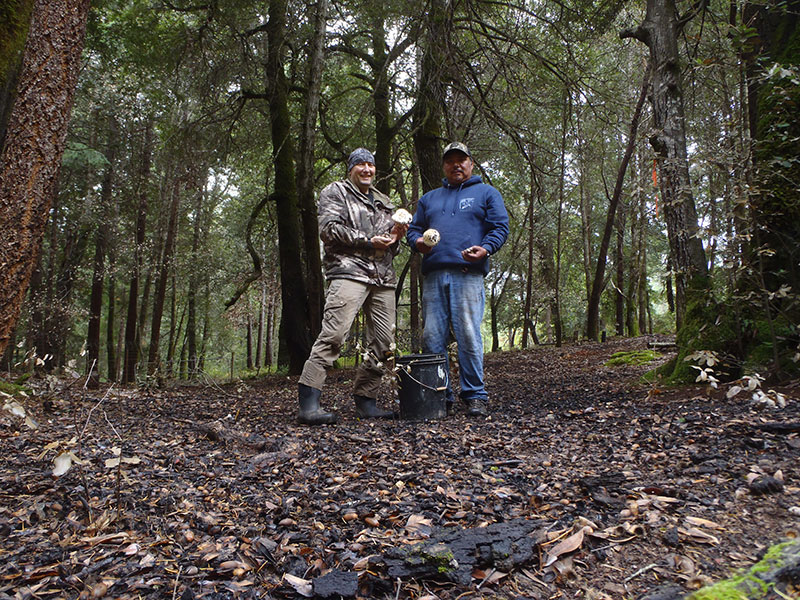
But even if you don’t have a place where you can tangibly show that kind of change, we have five million acres to think about across this part of North America, and you can make an impact. Even referring to my trees as an orchard makes a difference. My neighbor was like, “What do you mean, orchard?” I said, “You see the artifacts over there for food processing: the hopper base, the acorn cooking and cracking rocks? The chicken coop, and the red clay? And remember in the wintertime when the gopher turned up some arrowheads? This has been a hunting and gathering place, and we’re reviving the orchard.”
People think, “That’s just an oak-dominated forest,” but when we start saying “orchard” we get them to change the context. They say, “You’re right.” The architecture and composition of the forest, the branch structure, everything—even with fire as a form of pruning—developed across generations at that site for those hundreds-of-year-old oaks. If we just dismiss that as a naturally regenerating forest that has some effects by fire and don’t call it an orchard, we miss that connection of human agency that developed it, and we wouldn’t see the potential for human agency now and into the future.
Do you have any final words that you’d like to share with Leaf Litter readers?
Try, with humility, to learn the history of your place. That means more than just a land acknowledgement; it’s also acknowledging what has happened there. Know the factors of colonization. Try to be open to a diverse perspective from tribal people that you may not be familiar with. Building trust requires hard truths and reconciliation.
When communities don’t trust the federal government, I often see agency representatives say something like, “They just have to get to know us better.” No. There are reasons the tribe distrusts the federal government. Acknowledging that is a starting point. Understand, when you come as an academic, or a person affiliated with an organization, branch of government, or another potential partner, what kind of history and baggage you bring. Acknowledge that, and then be like, “Okay. What services can we provide to help you with what you want to achieve?” Where do those tribal values, and priorities, and objectives align with your own? Then work to support the tribe to achieve that.
Building trust requires hard truths and reconciliation.
Sometimes agencies have somebody come in for a while, and after tribal members teach them and befriend them, that person gets promoted and transferred out. Part of Indigenous knowledge is having responsibility for that knowledge. This is a hard thing to say, but if you’re going to ask a question, be willing to take responsibility for the answer you might receive. Too often in academia, we just ask questions. Knowledge is freely given out without responsibility. I constantly remind myself that when I have asked elders to be shown or taught something, I’m taking a responsibility for that investment. If I squander that, then they’ve wasted their time and knowledge on me.
Please know that the knowledge that you’ve been so kind to share with us will not be squandered.
At the same time, I’m just one person. There are so many Indigenous people that have experiences, voices, and knowledge that aren’t being heard from. I’m thinking particularly elderly and younger women. I talk about this in my Fire Management Today article about inclusivity of knowledge. Fire knowledge comes from a spectrum of the community. It’s not just that one person, it could be a whole range of people, and some of those might not even necessarily be in full agreement with each other. That difference of opinion or perspective is diversity, and we need to embrace diversity.
